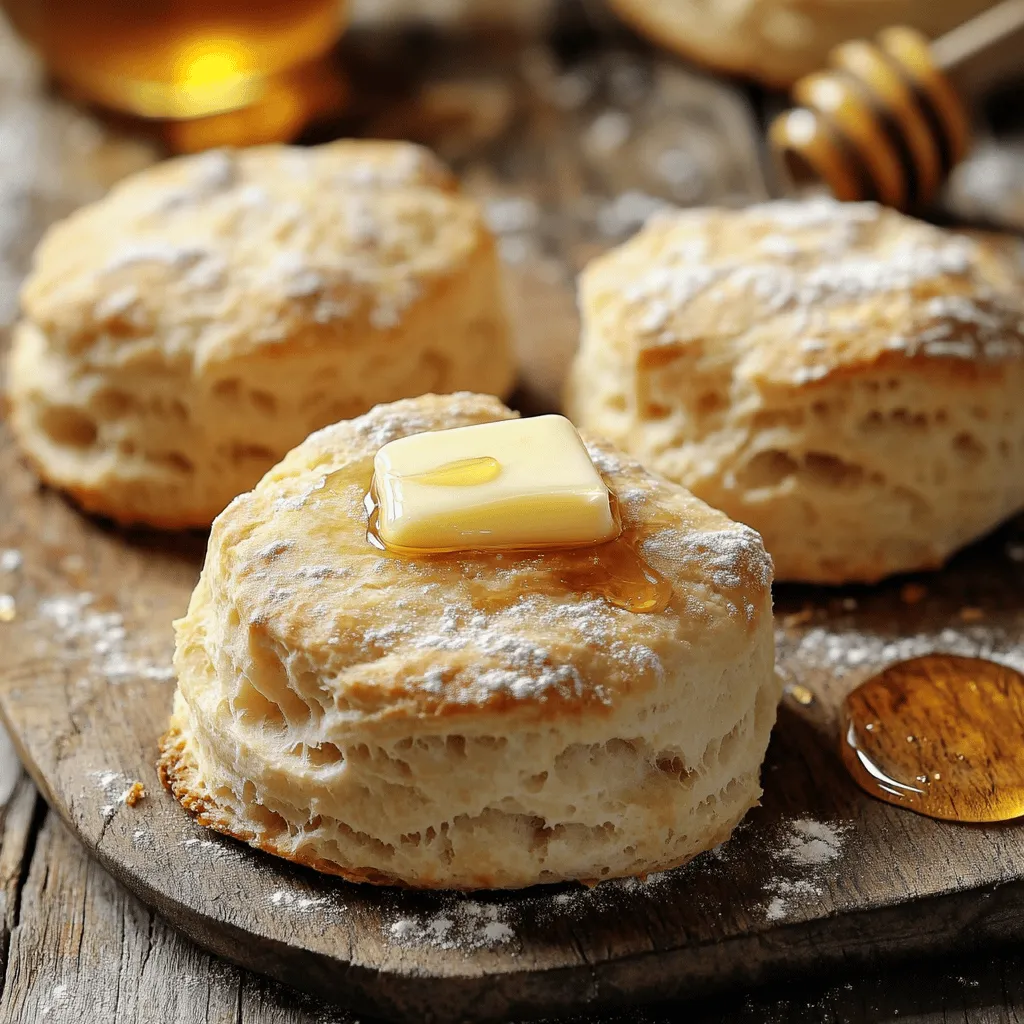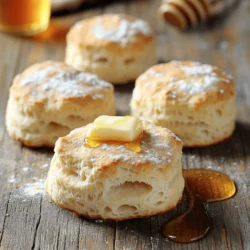Are you ready to elevate your baking skills with homemade biscuits? This simple recipe guarantees a fluffy texture that will impress anyone. I’ll share essential ingredients, step-by-step instructions, and tips to avoid common mistakes. Plus, discover various ways to customize your biscuits. Whether you’re a novice or an experienced baker, this guide will lead you to biscuit perfection. Let’s get started on your journey to the best biscuits ever!
Ingredients
List of Essential Ingredients
To make fluffy biscuits, gather these key items:
– 2 cups all-purpose flour
– 1 tablespoon baking powder
– 1 teaspoon baking soda
– 1 teaspoon salt
– 1/4 cup cold unsalted butter, cubed
– 3/4 cup buttermilk (you can use regular milk with a splash of lemon juice)
– 1 tablespoon honey (optional, to add sweetness)
– Extra flour for dusting
These ingredients work together to create a light and airy texture. The buttermilk adds a slight tang and helps with rising. Cold butter is crucial because it creates flaky layers.
Ingredient Substitutions
If you need to swap ingredients, here are some ideas:
– Flour: You can use whole wheat flour, but it may change the texture.
– Baking powder: If you run out, use 1/4 teaspoon baking soda and 1/2 teaspoon vinegar.
– Butter: Coconut oil or shortening can replace butter.
– Buttermilk: Mix regular milk with vinegar or yogurt for a quick substitute.
These swaps can help you stay flexible in the kitchen while still making tasty biscuits.
Tips for Choosing Quality Ingredients
When selecting your ingredients, keep these tips in mind:
– Flour: Look for a brand that is finely milled for the best texture.
– Baking powder: Check the expiration date for freshness. Old baking powder may not rise well.
– Butter: Choose unsalted butter to control the salt level in your biscuits.
– Buttermilk: If using store-bought buttermilk, check for a creamy texture.
Choosing quality ingredients sets the foundation for great flavor and texture. This attention to detail makes a noticeable difference in your final biscuits.
Step-by-Step Instructions
Detailed Process to Make Homemade Biscuits
To make fluffy homemade biscuits, follow these simple steps. First, preheat your oven to 450°F (232°C). Line a baking sheet with parchment paper to prevent sticking. In a large bowl, mix 2 cups of all-purpose flour, 1 tablespoon of baking powder, 1 teaspoon of baking soda, and 1 teaspoon of salt. This mix creates the base for your biscuits. Next, add 1/4 cup of cold, cubed unsalted butter. Use a pastry cutter or your fingers to blend until it looks like coarse crumbs.
Now, pour in 3/4 cup of buttermilk. If you don’t have buttermilk, mix regular milk with a splash of lemon juice. You can add 1 tablespoon of honey for a hint of sweetness. Use a wooden spoon to stir gently until just combined. Your dough will be a bit sticky, which is perfect!
On a floured surface, turn out the dough and pat it into a rectangle, about 1-inch thick. Be careful not to overwork the dough. This keeps your biscuits light and fluffy. Fold the dough over itself 3-4 times to create layers, which add flakiness. Then roll it out again into a 1-inch thick rectangle.
Using a round biscuit cutter or a glass, cut out biscuits. Place them on your prepared baking sheet. Press the cutter straight down without twisting for the best rise. Gather any scraps, re-roll, and cut more biscuits. Bake for 12-15 minutes. Look for golden brown tops. Enjoy your warm biscuits with butter, jam, or honey.
Tips for Each Step to Ensure Success
– Mixing Dry Ingredients: Make sure to whisk the dry ingredients well. This helps the baking powder and soda distribute evenly.
– Butter Temperature: Keep your butter cold. This helps create flaky layers.
– Handling the Dough: Always handle the dough gently. Overworking it can make your biscuits tough.
– Cutting the Biscuits: Use a sharp cutter. A dull cutter can squash the dough and prevent rising.
– Baking Time: Keep an eye on the biscuits. Ovens vary, so check them a couple of minutes early.
Common Mistakes to Avoid
– Using Warm Butter: Warm butter can lead to flat biscuits. Always use cold butter.
– Not Measuring Ingredients: Accurate measurements are key. Use dry measuring cups for flour.
– Overmixing the Dough: Stop mixing as soon as the dough comes together. Overmixing can ruin texture.
– Twisting the Cutter: Twisting when cutting can seal the edges. This stops the biscuits from rising properly.
– Skipping the Oven Preheat: Always heat your oven first. A hot oven is crucial for a good rise.
Follow these steps, tips, and avoid common mistakes. Soon, you’ll be enjoying delicious, fluffy homemade biscuits.
Tips & Tricks
Techniques for Achieving Fluffy Texture
To make your biscuits fluffy, use cold butter. Cold butter creates steam when baking, which helps the biscuits rise. Cut the butter into the flour mixture until it looks like coarse crumbs. This step is key for lightness. Fold the dough over itself multiple times to create layers. These layers help make each biscuit flaky and airy.
How to Keep Your Biscuits Moist
To keep your biscuits moist, don’t overmix the dough. Stir just enough to combine the wet and dry ingredients. Also, using buttermilk adds moisture, making biscuits tender. If you want a touch of sweetness, add honey to the mix. This can help keep the biscuits soft and flavorful.
Adjustments for Different Ovens
Ovens can vary in heat. If your oven runs hot, check biscuits a few minutes early. If your oven is cooler, they may need extra time. Always look for golden tops as a sign they are done. For even baking, try rotating the baking sheet halfway through. This helps ensure all biscuits bake evenly.

Variations
Buttermilk Biscuit Recipe
The buttermilk biscuit recipe is a classic. It gives a rich flavor and fluffy texture. When you mix buttermilk with baking soda, it creates a great rise in your biscuits. This recipe uses simple ingredients like flour, butter, and buttermilk.
Gluten-Free Biscuit Options
If you need gluten-free biscuits, you can swap regular flour for a gluten-free blend. Look for one that has xanthan gum, as it helps bind the ingredients. Use the same amount as you would with regular flour. This keeps your biscuits light and fluffy, just like the original recipe.
Sweet vs. Savory Biscuit Ideas
You can make biscuits sweet or savory. For sweet biscuits, add chocolate chips or dried fruit. A little honey or sugar can also add sweetness. For savory options, mix in cheese or herbs. Try cheddar and chive for a tasty twist. You can even add cooked bacon for extra flavor. Explore these variations to find your favorite!
Storage Info
Best Practices for Storing Biscuits
To keep your biscuits fresh, store them in an airtight container. This keeps out air and moisture. Place a paper towel inside to absorb extra moisture. Biscuits stay soft for about two days at room temperature. If you want them to last longer, refrigerate them. Just remember to wrap them tightly.
How to Reheat Biscuits for Optimal Freshness
To reheat your biscuits, preheat the oven to 350°F (175°C). Place the biscuits on a baking sheet. Heat them for about 5 to 10 minutes. This warms them through and keeps them fluffy. You can also use a microwave for quick heating. Just wrap them in a damp paper towel and heat for about 15 seconds.
Freezing Biscuits for Later Use
Freezing biscuits is a great way to save some for later. After baking, let them cool completely. Wrap each biscuit in plastic wrap and place them in a freezer bag. Make sure to remove as much air as possible. You can freeze them for up to three months. To use, thaw them in the fridge overnight, then reheat as mentioned earlier. Enjoy your homemade biscuits anytime!
FAQs
What can I do if my biscuits are too dense?
If your biscuits turn out too dense, don’t worry! You can fix this. First, check your measurements. Too much flour can weigh them down. Make sure to use a light hand when measuring. Next, use fresh baking powder. Old baking powder loses its power. You can also try cutting the butter into smaller pieces. This helps create more air pockets, which makes them fluffier. Lastly, don’t over-mix the dough. Mix just until combined to keep them light.
Can I make homemade biscuits without buttermilk?
Yes, you can still make great biscuits without buttermilk! If you don’t have any, use regular milk. Just add a splash of lemon juice or vinegar to it. Let it sit for about five minutes. This will mimic buttermilk’s tangy taste and help with rise. You can also use yogurt or sour cream. Just thin them out with a little water or milk until you get a smooth consistency.
How do I know when my biscuits are done baking?
You will know your biscuits are done when they look golden brown on top. If you press them gently, they should feel firm but soft. You can also check the bottom. It should be lightly browned. If you want to be sure, you can insert a toothpick into the center. If it comes out clean, your biscuits are ready. Enjoy them warm from the oven!
You learned about the key ingredients for great biscuits and their best substitutes. I detailed each step to make perfect homemade biscuits and ways to avoid common mistakes. You discovered helpful tips to achieve a light and fluffy texture, along with various biscuit recipes to try. Proper storage and reheating methods ensure your biscuits stay fresh. Remember, practice makes perfect. With these guidelines, you can bake delicious biscuits every time. Enjoy your baking journey!


